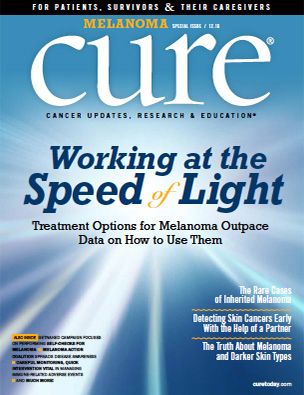Publication
Article
CURE
Partnering Up to Identify Melanoma
Author(s):
Checking skin with a trained partner can help to identify suspicious moles that may be skin cancer.
Performing skin self-examinations with a partner can help with early detection of new or recurrent melanoma, according to a study conducted by researchers at Northwestern Medicine in Chicago and published online in the journal JAMA Dermatology.
A total of 494 patients with a history of melanoma participated with a partner. The pairs in the study were trained on how to identify suspicious moles on the body.
“We delivered the intervention in three ways,” said June K. Robinson, research professor of dermatology and lead author on the study. “We delivered it with in-person training sessions with my research assistants using PowerPoint, a workbook that the two read in an office together and tablets that they looked at; then, they could discuss whatever they were reading or seeing.”
Pairs were randomized to one of four trial arms: control (no intervention), training with a workbook, in-person training or training with tablet. Informative sessions ranged from 20 to 45 minutes in length, and the patient-partner pairs on any of the three intervention arms learned how to recognize change in the border, color and diameter of moles. Together, they then gave the mole a score using a three-point system: 1 meaning normal, 2 meaning unsure and 3 meaning abnormal.
Robinson and her team reinforced the skills in four-month intervals over a two-year period. At each visit, data were collected through self-reported surveys that both patients and partners filled out separately, in different rooms. Both patients and partners received $20 for each assessment completed.
Among all 494 patients, 69 melanomas were identified in different individuals. Sixty-six were new melanomas and three patients had in-transit metastasis. Patient-partner pairs receiving an intervention (395 pairs) identified 43 of the melanomas successfully. However, patient-partner pairs in the control group were not able to identify any melanomas. Physicians identified melanoma in 16 different patients.
Robinson told CURE® the study’s findings can be beneficial in two ways. First, skin self-examinations can decrease anxiety and reduce the number of physician visits because patients have better control and understanding of their bodies.
“Early in the diagnosis of melanoma, they are very anxious about every boo-boo being another melanoma, and so they ring the phone and try to get an appointment with the doctor to be seen immediately,” she said. “If we give them a system that they can use to enable and empower themselves, then the anxiety level starts to decrease, because they can make rational decisions about how fast they have to go see the doctor.”
The second benefit is getting the patients — who think they don’t have to worry anymore because they’re five years out from treatment — to do their own skin checks with partners. Robinson said this is crucial because the risk of developing another melanoma continues for at least an additional 10 years.
The idea of studying skin self-examinations with a partner came to life from an experience Robinson had with a male patient. The steel worker, of Irish descent, worked outside for years and had a suspicious mole on his back. While Robinson was explaining to him what to look for in the future, he said he didn’t care, and told her to “talk to [his] wife.”
It dawned on her at that moment that partners may be the best way to get people to actually check their skin. To move this study forward, Robinson hopes to make the program deliverable by an app to smartphones. It would include all the important information that can be used in recognizing a suspicious mole. Anyone who felt a mole looked peculiar could take a photo and send it to Robinson to examine. The app, she says, could promote better behaviors, since it is easily accessible.
“A lot of younger people who have melanoma are working people who don’t want to take off from work to go to the doctor over nothing,” said Robinson. “And the older people, they don’t want to travel through traffic to get to the doctor’s office for nothing. So, the reassurance that they can take and send an image with a smartphone in a way that's accessible and easy can take the program up a notch.”





